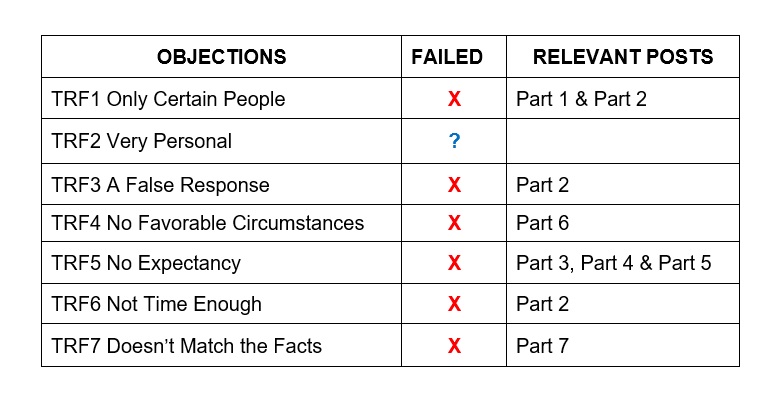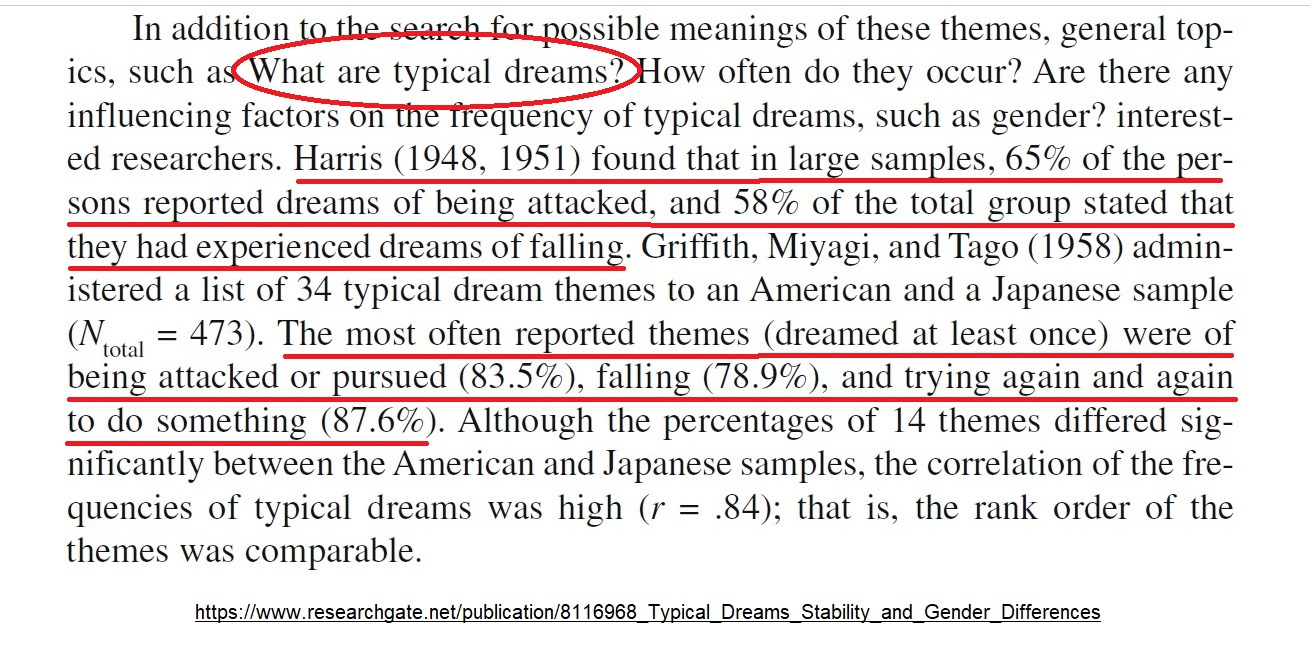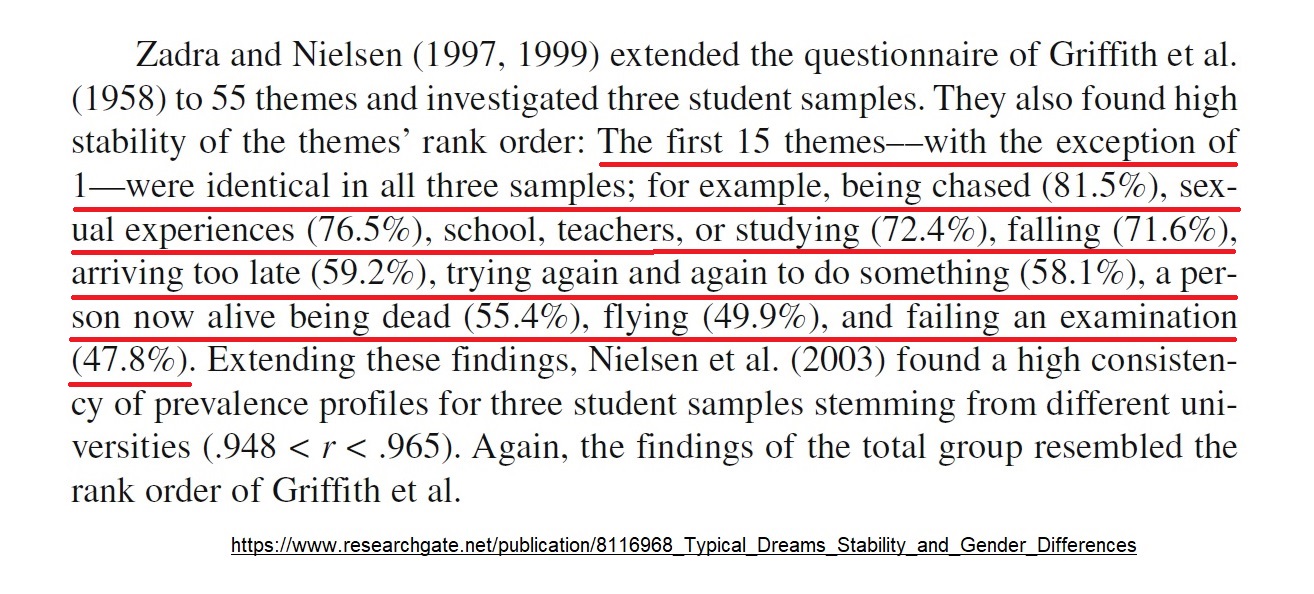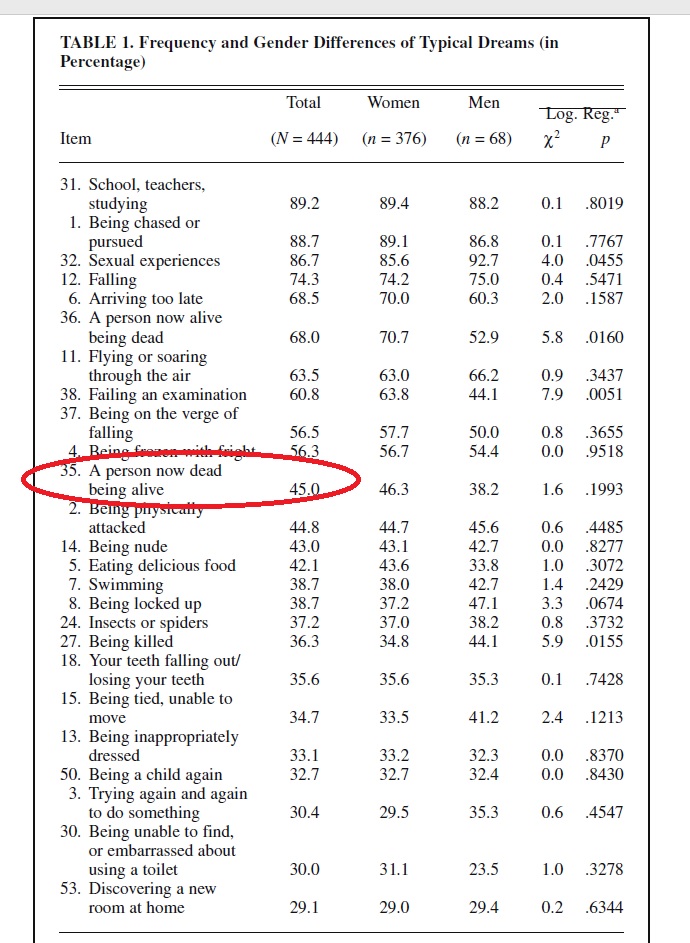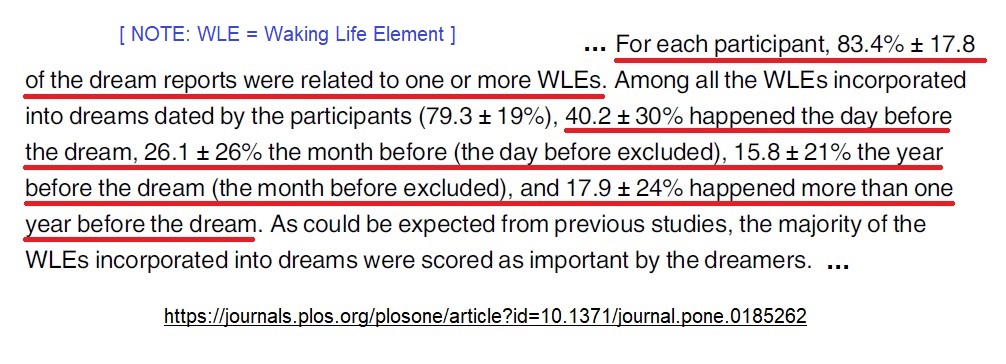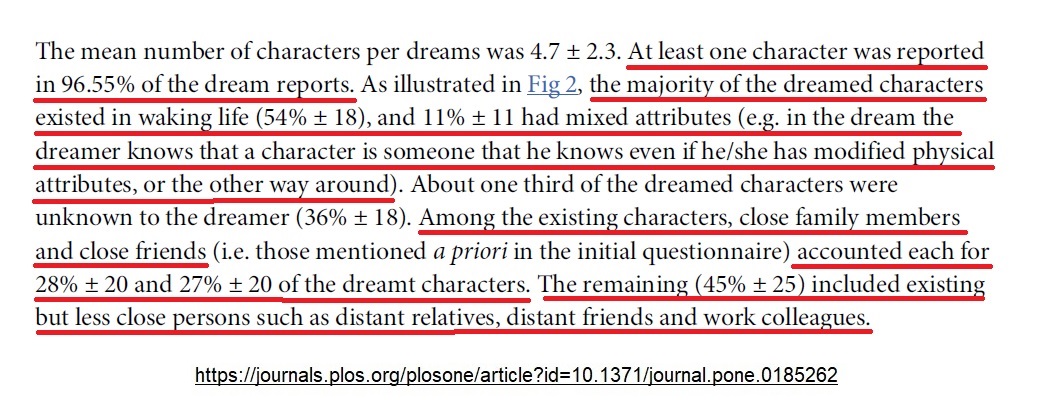Did Jesus Rise from the Dead? Part 8: The VERY PERSONAL Objection (TRF2)
WHERE WE ARE
In the previous seven parts of this series, I have shown that at least six out of the seven objections raised by Josh McDowell in The Resurrection Factor (hereafter: TRF) against the Hallucination Theory FAIL. So, at least 85% of McDowell’s objections against the Hallucination Theory FAIL:
Given that at least 85% of his objections FAIL, one may reasonably conclude that McDowell has no ability to distinguish between a good solid argument, and a weak and/or defective argument. So, it should be no surprise that in this current post, I will show that Objection TRF2 (“Very Personal”) also FAILS, and thus that McDowell has a perfect 100% failure rate, that ALL of his objections against the Hallucination Theory FAIL, and that McDowell is several fries short of a happy meal.
OBJECTION TRF2: VERY PERSONAL
Here is a basic assumption behind Objection TRF2:
Second, hallucinations are linked to an individual’s subconscious and to his particular past experiences, making it very unlikely that more than two persons could have the same hallucination. (TRF, p.84)
The alleged psychological “principle” here is that “hallucinations are linked to an individual’s subconscious and to his particular past experiences”. This, strictly speaking is an empirical generalization (unlike some of McDowell’s other psychological “principles”). However, I think that this idea is derived from an obvious CONCEPTUAL claim:
Hallucinations are completely subjective phenomena.
This CONCEPTUAL claim can be clarified as follows:
The contents of an hallucination experienced by person P are completely subjective, being produced purely by the mind of person P.
I have no objection to this CONCEPTUAL claim. It is a truth based on the meaning of the word “hallucination”, so there is no need for any scientific observations or experiments to confirm this claim. It is a claim that is known by all competent speakers of the English language who understand the meaning of the word “hallucination”.
McDowell has simply expanded on this CONCEPTUAL truth, by adding to it a plausible empirical assumption:
If an experience of person P is produced purely by the mind of person P, then that experience was produced by the subconscious of person P and by the past experiences of person P.
The concept of “the subconscious” is a rather dubious one, especially given the prominence of this idea in New Age Thought, which is dominated by stupidity, ignorance, and superstition (should be called: New Age Mindlessness). Nevertheless, although the concept of “the subconscious” is VAGUE, UNCLEAR, and surrounded by confused superstitions, the basic idea that a good portion of our own thinking happens outside of, or on the periphery of, our immediate awareness, seems very reasonable, if not undeniable.
I think for our purposes here, it is probably not necessary that we pin down the precise meaning of “the subconscious”. So, setting aside my discomfort with the UNCLARITY of that term, I’m willing to accept this empirical assumption made by McDowell, as being at least a reasonable assumption. This empirical assumption, however, is just one of common sense; it is NOT a well-established scientific claim that is based on careful scientific investigation or experiments.
NOTE: Freud rejected the use of the term “the subconscious” because he thought it was ambiguous and misleading. So, it is unlikely that “most” psychological experts would endorse McDowell’s empirical assumption or the empirical psychological “principle” that is the basis for Objection TRF2.
AN INFERENCE FROM THE PSYCHOLOGICAL PRINCIPLE
McDowell draws an inference from his psychological “principle”:
…making it very unlikely that more than two persons could have the same hallucination. (TRF, p.84, emphasis added)
I think he meant to say “more than one person” here. First, McDowell learned this objection from J.N.D. Anderson’s pamphlet The Evidence for the Resurrection, which was published in 1950, more than thirty years before McDowell’s book The Resurrection Factor, and Anderson makes the stronger claim:
No two persons will experience exactly the same phenomenon.
Furthermore, in his more recent defense of the resurrection in Evidence for the Resurrection (hereafter: EFR), McDowell argues against two people having the same hallucination:
…making it very unlikely that two or more persons could have the same hallucination at the same time. (EFR, p.207, emphasis added)
So, McDowell does want to make the stronger claim against two people having the same hallucination, similar to the version of this objection put forward by Anderson in 1950.
Can two people experience the same hallucination? McDowell FAILS to notice that this question is AMBIGUOUS. It depends on what one means by “the same hallucination”.
In one sense, it is IMPOSSIBLE for two people to experience “the same hallucination”. In his more recent book on the resurrection, McDowell quotes the apologist Michael Licona and the psychologist Gary Collins who both make this point:
Michael Licona has observed, “Hallucinations are like dreams. They are private occurrences. You could not share an hallucination you were having with someone else…” (EFR, p.208)
Clinical psychologist Gary Collins explains, “Hallucinations are individual occurrences. By their very nature only one person can see a given hallucination at a time. …Since a hallucination exists only in the subjective, personal sense, it is obvious that others cannot witness it.” (EFR, p.208)
Both Licona and Collins are making a CONCEPTUAL claim, and they are both correctly asserting an analytic truth. But McDowell is AGAIN confusing a CONCEPTURAL claim with an EMPIRICAL claim.
You cannot prove or establish an EMPIRICAL claim simply on the basis of a CONCEPTUAL claim. Empirical claims must be supported by experiences, observations, or experiments. The CONCEPTUAL claim that Licona and Collins are making is based purely on the meaning of the word “hallucination”; it is NOT based on experiences, observations, or experiments. Any competent speaker of the English language who understands the meaning of the word “hallucination” knows the analytic truth that Licona and Collins assert. This is NOT a scientific claim. Because these quotes by Licona and Collins assert a CONCEPTUAL claim, they do not provide relevant evidence in support of McDowell’s EMPIRICAL claim.
It is clear that McDowell is making an EMPIRICAL claim, because he uses the qualifying expression “very unlikely”:
…making it very unlikely that more than two persons could have the same hallucination. (TRF, p.84)
…making it very unlikely that two or more persons could have the same hallucination at the same time. (EFR, p.207)
If McDowell was asserting a CONCEPTUAL or analytic truth that no two persons can experience the same hallucination, then it makes no sense for him to use the qualification “very unlikely”.
That is like saying it is “very unlikely” that we will see a four-sided triangle today, or that it is “very unlikely” that we will meet a married bachelor today. It is logically impossible for a triangle to have four sides, so there is not even a remote chance that we will see a four-sided triangle today. It is logically impossible for a person to be both a bachelor and to be a married person at the same time, so there is not even a remote chance that we will meet a married bachelor today. The qualification “very unlikely” thus clearly implies that McDowell has in mind an EMPIRICAL generalization which could, at least in principle, have some exceptions. The use of the qualification “very unlikely” thus clearly implies that McDowell is NOT asserting a CONCEPTUAL claim or analytic truth.
It might be easiest to first consider the analogous claim made about DREAMS:
Two people cannot experience the same dream.
This statement is ambiguous between a CONCEPTUAL claim (an analytic truth) which has ZERO possible exceptions, and an EMPIRICAL claim which, at least in principle, could have some exceptions. Think about how we enumerate or count the number of dreams that people are having. A man has a dream about a cat walking across the foot of his bed. That is ONE dream. A woman who is sleeping next to that man also has a dream at the same time. That is a second dream that is occurring. We are now talking about TWO dreams; one dream in the mind of the man, and another dream in the mind of the woman. Because these are two separate dreams, there is a sense in which they are NOT “the same dream”.
However, it could be the case that the woman is also having a dream about a cat walking across the foot of the bed. In fact, it is possible that they are both dreaming about a full-grown orange tabby cat walking slowly across the foot of the bed. In this case, there is a sense in which they are both having “the same dream”.
It is possible to compare one person’s dream with another person’s dream, and to note similarities and/or differences between those dreams. When the description of the contents of one dream closely matches the description of the contents of another dream, we are inclined to say that the two people who experienced those two dreams had “the same dream”. Such comparisons of dream contents can be the basis for EMPIRICAL claims, such as “John and Mary had the same dream last night”. It is possible for two people to have “the same dream” in this sense. Two people can experience dreams that are very similar in content. Thus, it is possible, at least in principle, for two people to have exactly the same dream, in that it is possible that a very detailed description of each person’s dream reveals no differences between the contents of those dreams.
McDowell has confused the CONCEPTUAL claim that “Two people CANNOT IN PRINCIPLE have the same hallucination” with the EMPIRICAL claim that “Two people are VERY UNLIKELY to have hallucinations with the same content”. The truth of the CONCEPTUAL claim does NOT show that the EMPIRICAL claim is also true. So, AGAIN McDowell FAILS to provide relevant evidence in support of this key factual claim in his Objection TRF2. He basically commits the fallacy of EQUIVOCATION by offering evidence in support of the CONCEPTUAL interpretation of this claim (which requires no evidence), but then asserts and assumes that he has provided evidence in support of the EMPIRICAL interpretation of this claim (which requires experiences, observations, or experiments as confirmation).
The above example of two people dreaming about a full-grown orange tabby cat shows not only that it is possible in principle for two people to have “the same dream”, but that there is a SIGNIFICANT CHANCE of this happening. There might be a full-grown orange tabby cat living in the house with this couple, and that cat may sometimes walk slowly across the foot of their bed. In fact, the tabby cat might have slowly walked across the foot of their bed just before they went to sleep on the night in question, and thus it would not be a huge coincidence if both of them happen to dream that night about their cat slowly walking across the foot of their bed. So, it is not merely possible in principle for two people to have “the same dream”, there is also a SIGNIFICANT CHANCE of this actually happening, from time to time.
Given that there is a significant chance that two people can have “the same dream”, it seems reasonable to infer the same is true of hallucinations. There is a SIGNIFICANT CHANCE that two people could have “the same hallucination”, in the sense that detailed descriptions of their individual hallucinations could reveal no differences between the contents of those hallucinations.
HINTS OF ANOTHER ARGUMENT
Although McDowell offers irrelevant quotations (about a CONCEPTUAL claim) in support of his empirical claim that it is
…very unlikely that two or more persons could have the same hallucination at the same time. (EFR, p.207)
He also provides hints of another more plausible argument:
Christ appeared to many people, and descriptions of the appearances involve great detail… (TRF, p.84)
Let’s think of this idea in terms of dreams.
Sometimes we dream but don’t remember the contents of our dreams. Sometimes we remember a dream, but only a brief moment of the dream. Sometimes we dream and remember a chain of events in, and lots of details of, the dream. When we do remember the “story” of a dream and lots of details from the dream, we see that dreams are, or can be, fairly complex and full of details. If all I can remember from a dream is that I saw a cat, and I don’t remember the color of the cat or the type of cat or what the cat was doing, then I probably am not accurately remembering the full dream and all of its details. If, however, I remember dreaming about a full-grown orange tabby cat walking slowly across the foot of my bed, then I have remembered a fair amount of details of that dream.
With such details, we can imagine a wide variety of dreams that are similar but not the same as that dream. A slightly different dream would be of a kitten that was an orange tabby cat slowly walking across the foot of my bed. Or alternatively, a dream could be about a full-grown grey tabby cat slowly walking across the foot of my bed. Or a full-grown orange tabby cat quickly running across the foot of my bed, or quickly running across a desk, or… there are many different possible permutations, given this set of details.
For the simple description “a full-grown orange tabby cat slowly walking across the foot of my bed” we can abstract various general categories:
- AGE (newborn, infant, young, full-grown, old)
- COLOR (red, yellow, blue, green, orange, purple, gray, black, brown)
- TYPE/ANIMAL (tabby cat, Shetland pony, pointer dog, rattle snake, Angus cow, etc.)
- LOCOMOTION (walking, skipping, hopping, running, tumbling, crawling, etc.)
- SPEED (very slowly, slowly, moderately, quickly, very quickly, at full speed)
- LOCATION (the foot of, the middle of, the top of, underneath, along the side)
- OWNERSHIP (my X, your X, Our X, Sam’s X, Mary’s X, etc.)
- FURNITURE (bed, couch, dresser, table, easy chair, nightstand, bench, shelf, desk, etc.)
Clearly the possible permutations exceed five possibilities for each of eight categories, so the possibilities exceed 5 to the 8th power or 25 to the fourth power or 390,625 different possibilities. So based on the fairly simple description “a full-grown orange tabby cat slowly walking across the foot of my bed” we can generate similar yet different combinations of descriptions of possible dream contents that number around a half a million alternatives, without breaking a sweat.
This is why, I suspect, that McDowell focused in on the idea of “descriptions” that “involve great detail”. The more details we have to describe a dream or an hallucination, the more alternative possibilities we can generate based on one such description. It is easy to provide enough description of the details of a dream or hallucination, so that there will be literally millions or billions of alternative possibilities that are similar to, yet different from, that original description. Because the contents of dreams and hallucinations seem somewhat random and include a huge range of possibilities, including chains of events that would contradict ordinary experience and the laws of physics (if they happened in real life), it seems reasonable to McDowell to infer that it would be “very unlikely” for two hallucinations to have the same contents, assuming that the hallucinations were described with a fair amount of detail.
THE CONTENTS OF DREAMS AND HALLUCINATIONS ARE NOT PURELY RANDOM
The problem with this reasoning, which I suspect is the actual basis for McDowell’s conclusion, is that as with the case of the orange tabby cat, two people can have similar ordinary waking experiences that influence the contents of their dreams, or the contents of their hallucinations. Just as two people can both physically see an actual full-grown orange tabby cat walk slowly across the foot of their bed just before they fall asleep, two people can both physically see a full-grown tabby cat walk slowly across the foot of their bed just before they both take a large dose of LSD and begin to hallucinate.
As McDowell himself states, the contents of a person’s hallucinations are based in large part upon their “particular past experiences” (TRF, p.84). So, if two people share some of the same or very similar “past experiences”, then those experiences can make it more likely that they will have “the same dream” or “the same hallucination” or very similar hallucinations.
It is true that if we randomly select two hallucinations from the experiences of a large and diverse population of people who have had one or more hallucinations, and if the descriptions of those hallucinations are given in fair detail, it is very unlikely that the contents of those two randomly selected hallucinations will be identical. However, there is some chance that the hallucinations will be somewhat similar in contents, just because there are lots of experiences that people have in common, and lots of emotional responses to experiences that people have in common.
Furthermore, if we are not dealing with a random selection of hallucinations from the experiences of a large and diverse population of people, the chance that the people in the target group have had many similar experiences ordinary waking experiences and similar emotional responses to those experiences can be significantly increased, thus making it much more likely that two selected hallucinations are “the same” or very similar in content. For example, what if the target group of people were all devout Jews who lived in Palestine in the first century, and they were all followers of a particular Jewish preacher and faith healer? These people would have a lot in common in terms of their beliefs, values, practices, and they would have many common experiences and common emotional responses to those common experiences. They would likely have some similar dreams, and those that experience hallucinations would be likely to have some similar hallucinations.
We are now facing a more interesting empirical psychological question. To what degree do people who live in the same country in the same decade and who have the same religion and culture have SIMILAR DREAMS and SIMILAR HALLUCINATIONS? This is where expert scientific psychologists and their investigations and experiments could be of help. Unfortunately, McDowell doesn’t have the slightest clue about modern scientific study of dreams and hallucinations. His psychological “principles” did NOT originate with psychological experts, nor with any peer-reviewed scientific articles and books about hallucinations. He simply made this shit up, or else borrowed this shit from other scientifically ignorant Christian apologists, like J.N.D. Anderson or Paul Little.
SOME EMPIRICAL DATA ABOUT DREAMS
=>Dreams Reflect Concerns about Daily Life
=>People Often Have Similar Dreams
The subjects of the studies by Zadra and Nielsen were STUDENTS. Note that some of their most common dreams involved common experiences and fears of students: school, teachers, or studying, and arriving too late, and failing an examination. This is a strong indication that the contents of dreams are often related to the sorts of emotions and events that the dreamers have commonly experienced in their waking lives.
A more recent study of dream contents provides a list of the most common types of dreams people have:
Note that one of the more common dream types that people experience is “A person now dead being alive”!!
=>Dreams Are Usually Related to the Waking Experiences of the Dreamer
DREAMS AND HALLUCINATIONS
The contents of DREAMS are clearly NOT purely random. Common experiences shape us so that we tend to dream about similar things and similar events and similar experiences.
I don’t have this sort of data on the contents of hallucinations, but it is reasonable to draw the inference that hallucinations, being produced by the minds of the people who have the hallucinations, are similarly influenced by past experiences, and thus that common experiences will tend to produce common hallucination contents. It is reasonable to infer that like dreams, hallucinations are NOT purely random.
In any case, McDowell’s reasoning against the likelihood of two people experiencing “the same hallucination” will not work against the likelihood of two people experiencing “the same dream”, so this objection is, at best, a WEAK OBJECTION against the DREAM THEORY. This is especially the case given that 45% of people in one study reported having had a dream in which “A person now dead was alive”! For this reason alone, Objection TRF2 FAILS.
Assuming that hallucinations are also shaped by past experiences, as McDowell himself asserts, hallucinations can be shaped by common experiences, and thus there could be a significant chance of two people experiencing “the same hallucination”. This is particularly the case when the two people in question have a lot in common in terms of culture, beliefs, values, and experiences (such as both being devout Jews who live in Palestine in the first century, and who are followers of the same Jewish preacher and faith healer, and who have both recently observed this beloved Jewish preacher being crucified by Roman soldiers). Thus, Objection TRF2 also appears to be a WEAK OBJECTION against the Hallucination Theory (understood in terms of the narrower sense of “hallucinations”).
TO BE CONTINUED…
Articles on Dream Contents:
Why People Have Similar Dreams
Typical Dreams: Stability and Gender Differences
Dreaming and waking consciousness: a character recognition study

